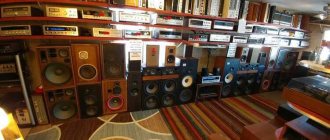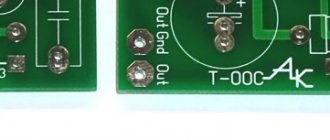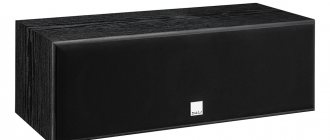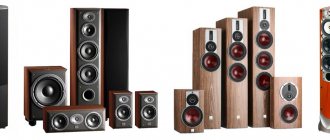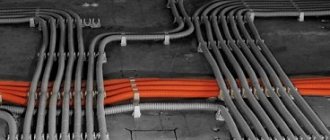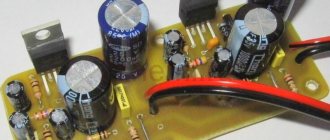What is an amplifier for?
Many car owners cannot enjoy loud music while traveling. At first glance, the problem can be solved by buying a good radio and speakers. But again, unnecessary interference arises, you just have to turn up the volume. Car enthusiasts who do not understand acoustic systems will blame the speakers, which, in their opinion, were not of such quality, because the radio has sufficient power.
In fact, the power indicated by the radio manufacturer is maximum and is provided for a short period of time, and this is not enough to listen to loud music, which is what causes squeaks, noises or wheezing. Also, the signal going from the radio to the speakers gets distorted. To eliminate these distortions, as well as strengthen the radio signal, a car audio amplifier is needed.
If we talk about the design of the amplifier, it consists of four components. To generate and regulate voltage, the device has a power supply. There are also two blocks that process input and output signals and a driver. First, the signal enters the input signal block, here the signal is “checked” for the presence of distortions and their removal. After which the driver will divide the received signal and amplify it. The signal will now be passed to the output signal block.
Where and how best to install
When installing such a device in a car, the main thing is to choose the right place. This place should provide not only protection from moisture and the possibility of mechanical damage, but also should allow the amplifier to cool. At the same time, the amplifier should not create inconvenience and discomfort for both the driver and his passengers. It is also necessary to take into account that wires will need to be pulled to the device, which must be positioned correctly, otherwise white noise will occur.
Now you can consider the main places where you can install the amplifier, and all the advantages and disadvantages of a certain location of the device. Quite often they are installed under the front seat. This way the unit will be located quite close to the energy source and sound source, which is a significant plus. Also, such an installation will not “steal” useful space in the car. But there will not be enough air circulation and space under the car seat, which will lead to overheating. In addition, the unit will be located far from the speakers and subwoofer.
In sedans, the amplifier can be installed under the shelf in the trunk or under the rear window. This will ensure that the device receives enough air without causing overheating. Since there is enough space, a high-power unit can be installed, and the vehicle owner will have access to both the device and the wiring. However, such an installation will not take up the required space; it will simply make the back wall a little thicker. The main disadvantage here may be the thin back wall. Due to this, the device cannot be securely fastened, and rattling or vibration may occur when driving on uneven roads. Also, the case will constantly beat, which will subsequently lead to distortion of the reproduced sound or even to a short circuit.
It will be quite convenient to mount the unit on one of the side walls of the trunk. This method is very convenient both for installing the amplifier itself and for connecting the wiring. In this case, the device will not take up useful space in the trunk and will not spoil the appearance, and it is also worth noting that air will always pass to the unit and will not allow it to overheat. But in this case, the amplifier will be far from the power source and sound source, which is a disadvantage.
Those who like to stand out and emphasize their individuality can install the unit on the trunk lid. This method will allow the device to receive enough air without stealing free space. However, this option is not very reliable. Firstly, the trunk lid is not thick enough, so the screwed parts will become loose and rattle over time. Also, because of this, the trunk lid may be deformed and it will not close tightly. Well, don’t forget that moisture can get into the device. In addition, such an installation is very difficult, and difficulties arise with connecting the wiring. Wires can crack due to temperature changes, resulting in a short circuit.
A fairly practical way is to install it on the back of the rear seat. This is a fairly simple method that will not take much effort, and in this case the unit will receive the necessary air and will not overheat. The amplifier will be close to the speakers, will not take up useful space and will be securely fastened due to the metal panel on the seats. The disadvantages of this method include the fact that the unit will be located far from sound and power sources, and kinks may also occur on the wires.
Types of car audio amplifiers
First of all, such units can be classified into classes. The clearest sound is provided by A-class devices. But they have a small percentage of efficiency, which varies between 20-30%. Therefore, most of the sound will be lost. Also, such options have a high cost. Due to this, they are not very popular among drivers.
The next class is B. Compared to the previous version, there is a little more power here, but the sound has some distortion. For this reason, this option is not used in cars. There is also a C-class, which has high efficiency, but at the same time greatly distorts the sound.
The modern version, which has digital signal processing, belongs to the D-class. This option is compact in size, does not distort the sound much and has high efficiency.
But still, AB-class models are more popular. They are analog devices that combine A-class sound frequency and B-class power. But such models have quite large dimensions and become very hot during operation.
In addition, amplifiers are classified by the number of channels. Single-channel models are used with subwoofers. They have quite high power, but the sound quality is not high. Such models in most cases require a filter for high and low frequencies. This will remove sounds that are not perceived by the human ear, however, they have a detrimental effect on equipment, as well as human health.
Models with three or two channels allow you to connect two speakers and a subwoofer. They can function perfectly with low impedance loads, and thanks to the bridge connection, high power levels are obtained.
The four-channel option is the most popular among users. Such models are a power supply that has outputs to two two-channel units. With their help, you can make various connections, for example, four speakers or two speakers and one subwoofer, as well as two subwoofers. Therefore, such models are not only practical to use, but also allow you to enjoy high-quality sound of your favorite music.
There are also options with five and six channels, but they are not very popular among buyers.
How to use the Bradex signal booster?
Unlike many hearing aids, Bradex's device does not require a doctor's prescription or multiple trips to the doctor. To feel the effect of using a signal amplifier, just follow a few simple steps:
- Remove the device from the case and insert the power supplies into the compartments located behind the earpiece;
- Close the compartment cover;
- Adjust the volume (the regulator is located behind the battery compartment);
- Insert the amplifier into your ear like a regular earphone;
- Enjoy clear and crisp sound.
This miniature device will be a real salvation for people who cannot fully enjoy the wonderful sounds of nature, conversations with loved ones, listening to songs and other such important things.
How to choose
When choosing an amplifier for a car, you should not ignore certain parameters that play a rather important role. First of all, this is the power of the model. Manufacturers indicate rated and maximum power. It is the nominal indicator that you need to pay attention to. In most cases, trusted manufacturers provide a certificate indicating the serial number of the product and the power measurements made at the factory.
You also need to pay attention to the harmonic distortion coefficient, which is designated THD. The sound frequency will depend on this indicator, so the lower it is, the better. It’s better to ask to connect the device and listen to its sound.
The build quality and manufacturer should not be ignored. Trusted companies that have proven themselves in the market are unlikely to disappoint in the future. Also, certain models may be designed for installation in a certain place, in this case, it is better to think in advance whether you will be able to mount the device in this part of the vehicle.
Schematic diagram of ULF on transistors 500 watts
The power amplifier circuit is shown in the figure above. This is a classic circuit design consisting of a differential input amplifier and a symmetrical power amplifier, in which 5 pairs of transistors operate. Transistors T2 (MPSA42) and T3 (MPSA42) operate in a differential amplifier circuit powered through resistors R8 (10k) and R9 (10k). The voltage in the middle of this divider is stabilized using zener diode D2 (15V/1W) and filtered by capacitor C4 (100uF/100V). The input signal is fed to the GP1 (IN) connector and filtered through elements R1 (470R), R3 (22k), C1 (1uF) and C2 (1nF), which limit the frequency range of the amplifier both above and below.
The load of the differential amplifier is transistors T1 (MPSA42) and T4 (MPSA42), operating in a system with a common base, as well as resistors R5 (1.2 k) and R6 (1.2 k). The polarity of the load is set by the zener diode D1 (15V/1W) and resistor R7 (10k). The main task of the system consisting of transistors T1 and T4 is to match the impedance of the output signal for the ULF stage. Another stage, built on transistors T5 (MJE350) and T6 (MJE350), acts as a differential voltage amplifier. It is powered through resistor R11 (100P/2W). Its load will be transistors T14 (MJE340) and T15 (MJE340), resistors R13 (100P/2W) and R14 (100P/2W), and transistor T7 (BD139).
Capacitor C15 (47nF), connected in parallel with resistor R44 (10k/2W), improves the passage of pulse signals, while small capacitors C7 (56pF) and C8 (56pF) counteract self-excitation of the UMZCH. Transistor T7 together with resistors R10 (4.7 k), R45 (82R) and potentiometer P1 (4.7 k) allows you to set the correct polarity of output transistors T9-T13 (IRFP240), T17-T21 (IRFP9240) at rest. Potentiometer P1 can be used to set the quiescent current, which should be about 100 mA for each pair of output transistors. Transistors T9-T13, like T17-T21, are connected in parallel and work as voltage followers for a large maximum output current. Therefore, the previous amplifier stages must provide all the voltage gain, which is determined by the ratio of R4 (22k) to R2 (470R) and is about 47.
Resistors R30-R39 (0.33 R/5W) included in the sources of the output transistors provide protection against damage that could occur in the case of different resistances of the transistor channels. Resistors R20-P29 (470R), connected in series with the outputs of transistors T9-T13, T17-T21, serve to reduce the charging rate of the capacitor and, therefore, limit the frequency range of the amplifier.
The amplifier has two simple protections:
- The first is aimed against overload and is implemented using zener diodes D3 (7.5 V/1W) and D4 (7.5 V/1W), which do not allow the voltage between the sources and outputs of powerful transistors to rise above 7.5 volts.
- The second protection is built using transistors T7, T16 and (BD136), resistors R16-R17 (33k) and R18-R19 (1k) and diodes D7-D10 (1N4148). It prevents the power transistor current from increasing excessively, which could lead to exceeding the permissible power. A section of the circuit consisting of transistors T7, T16 monitors the voltage drop across R30 (0.33 R/5W) and R35 (0.33 R/5W) and limits the increase in voltage of powerful transistors if the permissible current passing through is exceeded.
The power supply is not stabilized, bipolar, consisting of a diode bridge Br1 (25A) and capacitors C9-C14 (10000uF/100V). The amplifier's power supply is protected by fuses F1-F2 (10A). Behind the fuses, the voltage is additionally filtered by capacitors C18-C19 (1000uF/100V). The power supply of the input circuits is separated from the power supply of the power amplifier using diodes D5-D6 (1N4009), resistors R12 (100P/2W), R15 (100P/2W) and filtered by capacitors C3 (100uF/100V) and C6 (100uF/100V). This prevents voltage surges that can occur during power peaks under heavy loads. LEDs D11-D12, together with their current-limiting terminal resistors R40-R41 (16K/1W), are indicators of the presence of power in the circuit.
The best two-channel audio amplifiers
Most often, two-channel amplifiers are used to improve sound in a car or to connect a low-power subwoofer. However, they are not suitable for connecting a more powerful woofer because they do not have enough power to drive them. These devices are compact in size, allowing them to be installed under the seat or in the trunk. Among the features of amplifiers with two channels it is worth noting:
- Possibility of working in single-channel or dual-channel mode.
- Availability of low and high frequency filters. They are necessary to cut off a certain spectrum of frequencies that are incompatible with the range played by the speakers connected to them.
- The presence of a transistor linear output, necessary if there is another amplifier in the system.
- Availability of a high-level input for connection to standard audio systems of various car models.
To connect two-channel acoustics, you need to select an amplifier with power reserves. This will allow you to listen to music in high-quality sound and significantly extend the operation of the amplifier.
Alpine PMX-T320
This good car amplifier for two channels has a power of 2x50 W into a 4 ohm load. With a bridge connection, its power reaches 150 W. Despite the fact that this amplifier belongs to the lower model range, it uses a number of technologies that were previously used only in high-end devices. To eliminate extraneous noise, a special coil is installed in it.
The advantages include:
- compact dimensions;
- good workmanship;
- presence of a low-frequency amplifier;
- the presence of filters with an increased cutoff slope;
- use of high quality components.
Flaws:
- bass boost is not adjusted smoothly, but in steps.
Pioneer GM-A5702
This model has a total power of 1 kW. This allows you to safely use it in most automotive systems. The amplifier is designed to provide easy installation and powerful sound. Supports 2 and 4 ohm speakers.
Recommended for lovers of high-quality sound out of the box, because it has minimal sound customization capabilities.
Advantages:
- decent power;
- the presence of a low-pass filter;
- presence of bass boost.
Flaws:
- minimum filters and settings.
Ural BV 2.70
The amplifier has good power performance both with a load of 2 ohms and with a load of 4 ohms. Equipped with a wide bandpass filter that has independent adjustment of the lower and upper frequency ranges (from 10 Hz to 8 KHz). The high-quality all-metal housing allows for efficient heat dissipation, preventing the device from overheating. Compact dimensions will avoid installation problems. It can even be placed in the car under the seat.
Advantages:
Have an important event coming up? Don't forget the Bradex amplifier!
An audio signal amplifier has many advantages that can be appreciated by a person who does not have hearing problems. For example, you have an interview with an employer or a serious lecture at a university ahead. You ask, what in these situations can prevent you from perceiving sound normally?
Poor room acoustics, extraneous noise, even excitement - there are many reasons. There is only one solution: use the Bradex amplifier, which will save you from having to ask questions again and will not allow you to miss important information.
Just insert this miniature device into your ear and determine the desired volume level. Ready! With such a powerful amplifier, you can even hear a whisper. And the flesh-colored color and small size of the device will make it completely invisible to others.
The best four-channel amplifiers for the car
Ural DB 4.150 V.3
9,750 Our rating of the best amplifiers for speakers and subwoofers continues with the Ural DB 4.150. A very interesting option for the money, especially for fans of “analog” sound (the amplifier operates in the AB class) and an abundance of controls - there are really a lot of them on the side wall (plus an external controller is connected), and the eye immediately catches on the separate buttons for turning on the high-pass filter and low-pass filter on the front and rear pairs - and this already allows you to implement interesting connection schemes, without cutting off the frequency spectrum on only one side, but cutting out the desired band within the range of 10-8000 Hz. The nominal power of the channel at a 4-ohm load is 150 W, the distortion factor is 0.05%.
The sound of the amplifier does not cause rejection - it is quite capable of coping with low-sensitive acoustics, and not letting out flaws in the microrelief of the sound in highly sensitive ones. The handling of sudden volume jumps is good. But, of course, don't forget about power consumption (the 100 A fuse is a hint) and the associated power and cooling requirements.
Main advantages:
- Possibility of using a bandpass filter, and not just a low-pass filter or high-pass filter
- Good power reserve
- Sound quality
- Availability of a remote controller
Minuses:
- Power consumption and heating
9.5 / 10 Rating Reviews Compared to more expensive “imported” ones, I suddenly liked the sound even more.
Hertz DPower 4
12,800 Not the cheapest “cheap” device has, and expectedly, not the best distortion coefficient - 0.2% at a fixed frequency of 100 Hz with a load of 4 ohms. However, the manufacturer itself positions its amplifier as a “compact solution for upgrading standard systems” (which is why, in fact, it was also equipped with high-level inputs to the front and rear with automatic activation when a signal appears on them without using the Remote line).
In addition to the standard four-channel mode, the amplifier can operate as “two plus two” for multi-channel acoustics (the stereo signal is cut into two bands by crossovers), “one plus two” (the subwoofer is connected “in the bridge”, the remaining two channels operate on midrange/high frequency acoustics through external crossovers or to full-range speakers), or “swing” two stereo channels in a bridge connection. All that remains is to make the appropriate connections and select the modes and settings of the rear and front pairs of amplification channels - in general, you really get a universal “upgrade option”. A good amplifier for a car, but still for this money I would like a “evener” sound.
Main advantages:
- Connectivity versatility
- Compactness
- Moderate power consumption
Minuses:
- Average sound quality
9.3 / 10Rating Reviews I connected the front speakers and subwoofer to the bridge, and the amplifier made friends with the standard radio without any problems.
Bradex Audio Amplifier - Enjoy Every Sound!
A person perceives the world around him with the help of his senses. Most information is analyzed through vision, but sound is also extremely important for humans. Our world is filled with a wide variety of sounds that can cause joy or sadness, provoke anxiety or warn of danger.
For people suffering from hearing impairments, the world ceases to be complete, since the information received is not sufficient and does not cover all human needs. A Bradex household audio signal amplifier will help you cope with such a serious problem.
The best audio amplifiers for cars - rating (2022)
Art Sound XE 752
Two channel car amplifier
Art Sound XE 752 ($60) is an inexpensive two-channel car amplifier. The model is compact and easy to place in the cabin. It produces good sound and decent power for its price category. It should be enough for a subwoofer, but not for music for the whole street. Budget amplifier for cars, as it is.
The Art Sound brand is known mainly for inexpensive and fairly high-quality car amplifiers, the 2-channel amplifier Art Sound XE 752 is one of them.
+ / – Detailed ➕ / ➖⚙️ Characteristics Video review
- Worth the money ($60).
- Compact sizes.
- There is a low-pass filter and bass boost.
- High level input.
- Some subwoofers may not have enough power.
Pros:
- Price quality. Art Sound XE 752 is a budget two-channel car amplifier that costs $60. The increase in quality is best felt, of course, in comparison with standard systems.
- Compactness. Can be easily mounted under a seat or in similar “inconspicuous” places.
- Settings. Low pass filter, three-stage bass boost.
- High level input. Important for some radios.
Art Sound XE 752 connectors and regulators
Minuses
- Power. When connected with a bridge, you can swing the sub, but not every one.
- Class: AB
- Type: 2 channel
- Power RMS (4 Ohm), W: 50 x 2
- Power RMS (2 Ohm), W: 75 x 2
- Power RMS (4 Ohm bridge), W: 150 x 1
- Frequency range, Hz: 10 - 30000
- Signal/noise, dB: >90
- Crossover cutoff frequency, Hz: 50 - 250
- Dimensions, mm: 180 x 52 x 184
- Price: 60$
Equipment:
- Car amplifier Art Sound XE 752
- Cable
- Documentation
Pioneer GM-A6604
Car audio amplifier for music
Pioneer GM-A6604 ($135) is a high-quality car audio amplifier for music from a trusted manufacturer. 4 channels, class AB, reliable assembly and even quite interesting design. However, some may not have enough power. In terms of sound quality, it is one of the best options in its price category.
- TOP 15: Best portable Bluetooth speakers
- TOP 10: Headphones with good bass
For those who love low frequencies “above all else,” there is even a powerful bass booster.
+ / – Detailed ➕ / ➖⚙️ Characteristics Video review
- High quality sound.
- High pass and low pass filters, bass amplifier.
- No Subsonic filter.
- It gets hot when the subwoofer is connected.
pros
- Sound. Pioneer GM-A6604 makes the sound more detailed and natural, the positioning of instruments is felt, this is a truly high-quality car audio amplifier for music.
- Settings. High pass and low pass filters, bass amplifier.
Pioneer GM-A6604 connectors
Minuses
- No Subsonic filter.
- Heat. It is not critical, but very noticeable, especially, of course, when connecting a subwoofer.
- Class: AB
- Type: 4 channel
- Frequency response: 10Hz ~ 70kHz (+0dB, -3dB) Hz
- Distortion: <0.05%
- Signal-to-noise ratio: > 95 dB
- Maximum output power: 760 W (bridged) or 4 x 120 W (4 ohms) or 4 x 190 W (2 ohms)
- Power according to CEA 2006 (THD + N = 1%) : 4 x 60 W (4 ohms)
- Continuous Output Power (RMS): 4 x 60 W (4 ohms) or 4 x 90 W (2 ohms) or 2 x 180 W (4 ohms bridged mode)
- Bass boost: 50 Hz; 0 - 12 dB
- Load impedance: 2 - 8 Ohms permissible (stereo)
- High voltage input level: 300 mV - 6.5 V
- Speaker input level: 3 - 26 V
- Low pass filter (LPF): 40 - 500 Hz (-12 dB/oct)
- High pass filter (HPF): 40 - 500 Hz (-12 dB/oct)
- RCA type terminals: Yes (input)
- Speaker terminals: Screw type
- Maximum current consumption (A/4 Ohm): 31 A
- Chassis size (W x H x D) : 348(W) X 60(H) X 215(D) mm
- Unit weight: 2.3 kg
- Price: $135
Equipment:
- Four-channel car amplifier Pioneer GM-A6604
- Cable
- Screws for fastening
- Documentation
SWAT M-4.65
Budget amplifier for car speakers
SWAT M-4.65 ($60) is a budget amplifier for car speakers. 4 channels, class AB and only $60. A good option for those who want to improve the standard sound in the car, but do not want to spend large sums. You shouldn’t expect any revelations from the sound, but there will be progress (compared to the absence of an amplifier).
- TOP 15: Best portable MP3 players
- TOP 5: Best headphone amplifiers
- SWAT M-4.65 – budget 4 channel amplifier on Aliexpress
One of the most inexpensive 4-channel amplifiers, which is generally worth paying attention to.
+ / – Detailed ➕ / ➖⚙️ Characteristics Video review
- Good sound for the price ($60).
- Many connection options, high-pass, low-pass filters.
- Overload and short circuit protection.
- It gets hot when the subwoofer is connected.
- Not the most reliable terminals.
pros
- Price sound quality. SWAT M-4.65 is a budget amplifier for car speakers, and that says it all. $60 is justified. The sound is quite loud and detailed.
- Multifunctionality. 4 channels, there are high-pass and low-pass filters, the ability to connect with a bridge, even a high-level output.
- Overload and short circuit protection. Plus, of course, dubious. After all, this protection is found in any more or less high-quality amplifier (all of them in this rating).
SWAT M-4.65 inputs and outputs
Minuses
- Heat. It gets especially hot when a subwoofer is connected.
- Not the most reliable terminals. Damage can occur if you over-tighten the screws.
- Class: AB
- Type: 4 channel
- Frequency range, Hz: 10 - 20000
- Signal to noise ratio, dB: >95
- Power RMS (4 Ohm), W: 4 x 65
- Power RMS (2 Ohm), W: 4 x 100
- Power RMS (4 ohms/bridge), W: 2 x 200
- Input sensitivity, V: 0.2 - 6
- Bass boost, dB: 0…+12
- HF filter channels 1-2: 50 - 5000 Hz
- Low pass filter channels 3-4: 50 - 500 Hz / 500 - 5000 Hz
- Channels 1-2 crossover operating modes: HPF / Full
- Channels 3-4 crossover operating modes: LPF / Full
- RCA inputs and outputs
- High level input
- Supply voltage, V: 10 - 14.8
- Dimensions, mm: 300 x 220 x 52.5
- Price: 60$
Equipment:
- Car audio amplifier SWAT M-4.65
- Spare fuses
- Screws for fastening
- Documentation
Alpine PDX-V9
Car audio amplifier for speakers
Alpine PDX-V9 ($550) is a powerful and high-quality car audio amplifier for speakers. Class D, but the sound is excellent: lively, detailed. The overall power is very impressive, one might say, bordering on reasonable. In this case, the amplifier does not produce distortion.
- TOP 5: Best home theaters
- TOP 5: Best portable headphone amplifiers
The most expensive car amplifier in the rating from a trusted manufacturer. For those who want to close the issue with the amplifier once and for all.
+ / – Detailed ➕ / ➖⚙️ Characteristics Video review
- High quality sound.
- High power.
- Many components can be connected.
- A large number of settings.
- Interesting appearance.
- High price ($550).
- Complex installation scheme.
- Requires high-quality acoustics and head unit.
pros
- Sound quality. Alpine PDX-V9 is an excellent car audio amplifier for speakers. The sound is detailed and natural. He even “builds the stage” as much as possible in the car.
- Power. The amplifier produces a very loud and undistorted sound.
- Versatility. It is easy to build a full-fledged audio system based on this model.
- A large number of settings. All the necessary filters are in stock.
- Design. The amplifier is clearly not designed to hide it. By and large, there is only one decorative element – the frame. But it and the overall quality of performance give the amplifier its own “style”. The frame can be easily painted to match the interior color.
Why choose a Bradex audio signal amplifier?
- Compact dimensions;
- Sufficient coverage radius;
- No need for a doctor's prescription;
- Neutral colors;
- Wide range of equipment (batteries, cleaning brush, rubber headphones);
- Ease and safety of operation.
Together with the Bradex amplifier, all barriers between you and the outside world will be destroyed. Now you can fully enjoy the sounds that fill everyday life. Of course, clear sound perception is also a guarantee of safety, wherever you are.
Take responsibility for your health, especially since the solution to the problem is accessible and does not require much effort - just purchase a Bradex audio signal amplifier, which can be yours today.
Instructions
Starting and setting up the amplifier
- At the first stage, do not install power transistors T9-T13, T17-T21 and capacitors C9-C14 on the board.
- Potentiometer P1 must be turned all the way to the right. Instead of fuses, you need to solder 10R/5W resistors from below and connect a transformer.
- When turning on the transformer, we use the device to check the voltage drop across the 10R resistors. There should be a voltage drop of about 0.5V or less, since the board should not draw more than 50mA.
- Using a measuring device, we measure both supply voltages relative to ground. They should be about +/-80V.
- Turn off the supply voltage, discharge the filter capacitors using a small resistance resistor and proceed to soldering the power transistors T9-T13, T17-T21. All power transistors, together with T7, must be on a common heatsink to maintain good thermal stability of these elements. After installing the transistors, it is worth checking whether the radiator is touching any of the legs of the transistors, since it is connected to the ground of the amplifier.
- Power up the circuit, measuring the voltage drop across the 10R/5W resistor in the same way as before. The voltage drop should be the same on both arms of the ULF.
- Set the quiescent current. To do this, we very slowly rotate potentiometer P1 to the left (constantly measuring the voltage across one of the 10R resistors) until the voltage drop noticeably increases. We attach one end of the voltmeter to the output of the amplifier, and with the second probe we touch the sources of all transistors in turn, measuring the voltage drop across the resistors. The voltage drop should be approx. 30 mV, which gives a quiescent current per pair of transistors of the order of 100 mA.
- We measure the DC voltage at the output of the amplifier relative to ground; it should be close to zero and can fluctuate within +/-100 mV.
- If everything is correct, the quiescent current does not differ by more than 20-30% between transistors, and the output voltage is close to 0, then turn off the system power, unsolder the resistors and insert 10 A fuses into their designated sockets.
- Turn on the power and once again check the voltage drop across all ten resistors. If they are within acceptable limits, then you can connect a speaker and feed the input signal from the preamplifier.
- Setting up the UMZCH with the help of such an auxiliary protective power supply will be of great help.
The dangers of choosing the wrong amplifier
What can go wrong with the wrong choice? And how to choose an amplifier for speakers in terms of power so as to avoid possible problems?
Let's consider the following cases:
- The power of the amplifier is greater than the power of the speakers. It's not a big deal if you don't turn it on all the way. Ideally, 50-70% of the maximum will be enough. Moreover, this combination is believed to provide the highest quality sound. However, there is a risk that one day you forget and turn the volume to maximum - and this will damage the speaker cones. You might want to re-watch Back to the Future - at the beginning of the film, Marty McFly does exactly that, with devastating consequences.
- The power of the amplifier corresponds to the power of the speakers. Everything seems to be perfect. However, at maximum volume the acoustics begin to produce distortion, and the amplifier at its maximum can supply direct current to the speakers, which damages them. High-quality amplifiers, of course, are equipped with special capacitors to avoid “frying” the speakers with direct current. But it’s better not to take risks and run such a system at the same 50-70% volume at maximum.
- The power of the amplifier is less than the power of the acoustics. It would seem that there is no risk here. However, no: there is still a danger of “frying” with direct current if the amplifier is running at full capacity. If you turn it on at 60-70%, the risk is eliminated. However, the acoustics do not reveal the potential.
As for resistance (impedance), the combinations come down to the following options:
- The amplifier resistance is less than the speaker resistance. A dangerous combination: such speakers may not be able to cope with the signal supplied from the amplifier and may become damaged. It's better to avoid it.
- The amplifier impedance matches the speaker impedance. Ideal case.
- The amplifier resistance is less than the speaker resistance. You do not risk the serviceability of the equipment, but the actual output power will be one and a half to two times lower than the real capabilities of your acoustics. That is, the speakers won’t really sound.
Some amplifiers are equipped with either an impedance selector or different channels with different impedances. This model can simply be switched to a mode that matches your speakers. Other models are compatible with both 4-ohm and 6- and 8-ohm speakers, but power will drop inversely with impedance. The benefit here will be the guarantee that the speakers will work properly. In addition, if one day you think about how to choose speakers for an amplifier, you will have a wider choice.
